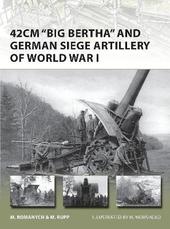
|
42cm 'Big Bertha' and German Siege Artillery of World War I
Paperback / softback
Main Details
| Title |
42cm 'Big Bertha' and German Siege Artillery of World War I
|
| Authors and Contributors |
By (author) Marc Romanych
|
|
By (author) Martin Rupp
|
|
Illustrated by Mr Henry Morshead
|
| Series | New Vanguard |
|---|
| Physical Properties |
| Format:Paperback / softback | | Pages:48 | | Dimensions(mm): Height 248,Width 184 |
|
| Category/Genre | First world war |
|---|
| ISBN/Barcode |
9781780960173
|
| Classifications | Dewey:355.822 |
|---|
| Audience | | General | | Professional & Vocational | |
|---|
| Illustrations |
40 b/w; 7 col
|
|
Publishing Details |
| Publisher |
Bloomsbury Publishing PLC
|
| Imprint |
Osprey Publishing
|
| Publication Date |
20 January 2014 |
| Publication Country |
United Kingdom
|
Description
In the early days of World War I, Germany unveiled a new weapon - the mobile 42cm (16.5 inch) M-Gerat howitzer. At the time, it was the largest artillery piece of its kind in the world and a closely guarded secret. When war broke out, two of the howitzers were rushed directly from the factory to Liege where they quickly destroyed two forts and compelled the fortress to surrender. After repeat performances at Namur, Maubeuge and Antwerp, German soldiers christened the howitzers 'Grosse' or 'Dicke Berta' (Fat or Big Bertha) after Bertha von Krupp, owner of the Krupp armament works that built the howitzers. The nickname was soon picked up by German press which triumphed the 42cm howitzers as Wunderwaffe (wonder weapons), and the legend of Big Bertha was born. This book details the design and development of German siege guns before and during World War I. Accompanying the text are many rare, never-before-published photographs of 'Big Bertha' and the other German siege guns. Colour illustrations depict the most important aspects of the German siege artillery.
Author Biography
Marc Romanych is a retired US Army combat arms officer. He has a BA in History from the University of Maryland and an MA in International Relations from St Mary's University. Interested in the Maginot Line since 1995, Marc has extensively explored its fortifications. He is a member of Association du P.O. de Sentzich, a Maginot Line preservation group. Marc lives near Baltimore, Maryland. Martin Rupp has a BA from the University of Applied Sciences, Saarbrucken. Since 1987, he has researched German records concerning combat operations against the Maginot Line and surveyed the battlefields upon which the battles occurred. From his findings, Martin produced an in-depth study of the German 95th and 167th Infantry Divisions' battle for Fortified Sector Faulquemont in June 1940. Martin lives in Saarbrucken, Germany.
Reviews"This superb and long-needed book covers the siege that Germany used against fortresses in its World War I offensive campaigns ... This is a must-have book for anyone interested in this subject!" --Coast Defense Journal ..".a fascinating book on a subject few have written. It is quite well done and I'd have to add this to the growing list of books that any enthusiast needs to have on their shelves." --Scott Van Aken, www.modelingmadness.com
|